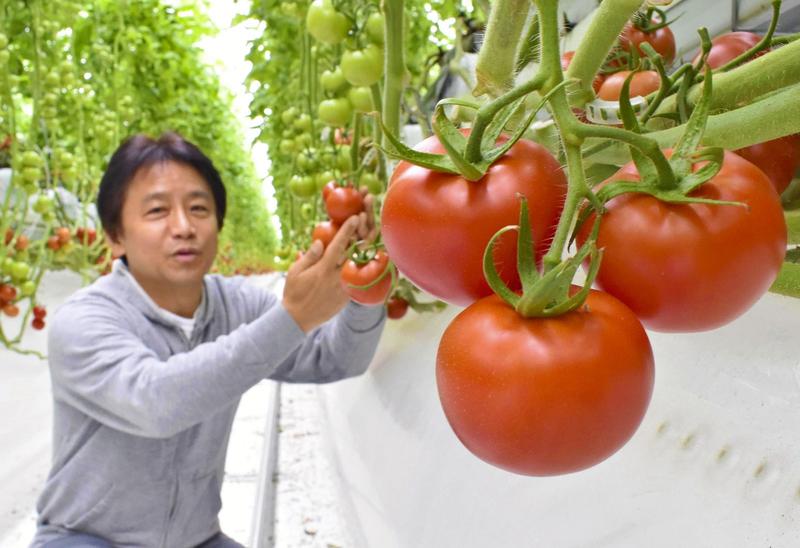 Satoshi Harada, manager of the cultivation technology group of Kagome Co, checks the growth of tomatoes at a greenhouse in Fujimi, Nagano Prefecture, Japan. (PHOTO / THE JAPAN NEWS)
Satoshi Harada, manager of the cultivation technology group of Kagome Co, checks the growth of tomatoes at a greenhouse in Fujimi, Nagano Prefecture, Japan. (PHOTO / THE JAPAN NEWS)
TOKYO (The Japan News/ANN) - At the foot of Mt. Yatsu-gatake, which straddles Nagano and Yamanashi prefectures, is a factory that is drawing attention in the farming industry as an ideal facility for contributing to a stable supply of vegetables.
Yatsugatake Mirai Saien farm is a tomato cultivating base for Kagome Co located in Fujimi, Nagano Prefecture. In this about 1-hectare plant factory, which opened last spring, notably red tomatoes grow throughout the year. The management of the temperature and humidity, as well as the supply of fertilizer and water in the greenhouse, are all controlled by computers.
Even the density of carbon dioxide needed for photosynthesis is controlled by adding carbon dioxide to air from the outside in a different room, which Kagome calls a “corridor.” The factory’s tomatoes are being sold at supermarkets and other venues as “high lycopene tomatoes.” Lycopene is believed to work as an antioxidant.
It’s necessary to develop a system in which vegetables can be grown stably, without being affected by outside environments.
Satoshi Harada, Manager of cultivation technology group of agricultural production department, Kagome Co, Japan
At Kagome’s conventional cultivation facilities, the inside temperature and humidity were controlled by opening and closing skylights, making the cultivating environment uneven. By adopting the latest technology, the yield per 4 hectare has reached 60 tons, up about 50 percent.
“It’s necessary to develop a system in which vegetables can be grown stably, without being affected by outside environments,” said Satoshi Harada, 56, the manager of cultivation technology group of the agricultural production department at Kagome.
Resisting global warming
Due to climate change and natural disasters, including a series of typhoons, the environment surrounding agriculture has become increasingly harsh. Amid this situation, companies are continuing to seek ways to enhance productivity in farming. Selective breeding of plants that go well with local climates has also become a matter of urgency.
ALSO READ: Mekong Delta agriculture adapts to climate change
Key Coffee Inc is raising seedlings of numerous varieties of coffee collected from various parts of the world at its directly managed farm in Indonesia. The company is continuing its search for varieties that have high resistance to the heat typical to the place of production and to agricultural pests.
Seedlings that the company planted about three years ago produced their first fruits last year.
“We’ve also found a promising variety that’s resistant to global warming,” an official in charge of public relations said confidently.
One factor behind their rush to selectively breed plants is the “Year 2050 issue for coffee” that has attracted attention in the industry. Due to the impact of global warming, the area suited for producing arabica coffee, the dominant cultivar, is expected to be cut by half in 30 years from now.
In Indonesia, the difference in temperature between daytime and nighttime — essential for the growth of coffee — have shrunk from at least 40 years ago when the company started its cultivation in the country. As things stand now, varieties of arabica coffee will run short, possibly making it difficult to supply relatively cheap coffee beans to Japan.
“We’d like to establish a cultivating method for new varieties of coffee within the next 10 years or so,” said an official of the company.
Culturing cow cells
Attempts are already underway to solve the increasingly serious food problems in the world, mainly in developing countries in Asia and Africa.
“We’re steadily increasing the cells of cows,” said a researcher at a laboratory in the University of Tokyo Komaba Research Campus in Tokyo. Mai Furuhashi, 27, a researcher at Nissin Foods Holdings Co, replaced culture fluids, which are nourishment for the muscle cells of cows, with a dropper, and confirmed through a microscope the movements of the cells.
She has come to this lab over the past 2½ years, conducting an experiment to create a block of meat by piling up clusters of meat cells with muscle fiber strung out.
In March 2019, Nissin Foods and the University of Tokyo announced they had successfully created a “cultured steak” measuring about 1 square centimeter.
They envision establishing culturing technology in five years’ time and putting lab-grown steak on the market in the future. Their technology might also be applicable to the culturing of such foods as chicken, pork and fish in the lab.
ALSO READ: Alternative meat can sustain food systems
Standard cuts risks of poisoning
To improve food safety, efforts to reduce the risk of food poisoning and other problems are also indispensable.
An international standard called the Hazard Analysis and Critical Control Point, or HACCP, is drawing attention in promoting hygiene maintenance.
This is an approach to hygiene maintenance for food safety in which the main causes of health hazards in production processes — such as contamination with bacteria or foreign substances — are analyzed to decide on and record the procedures so as not to cause food safety problems.
There has been progress in adopting this systematic approach, mainly in developed countries, and more countries are calling for imported and exported foods to undergo hygiene maintenance in line with the HACCP.
In Japan, it is expected to become mandatory in 2021 for all business operators, including food manufacturers and restaurant businesses, to condcut hygiene maintenance in line with the HACCP.
For the 2020 Tokyo Games, the Tokyo Organizing Committee of the Olympic and Paralympic Games is recommending that livestock such as meat and eggs be maintained in line with the HACCP, which is likely to boost momentum for introducing this approach.


